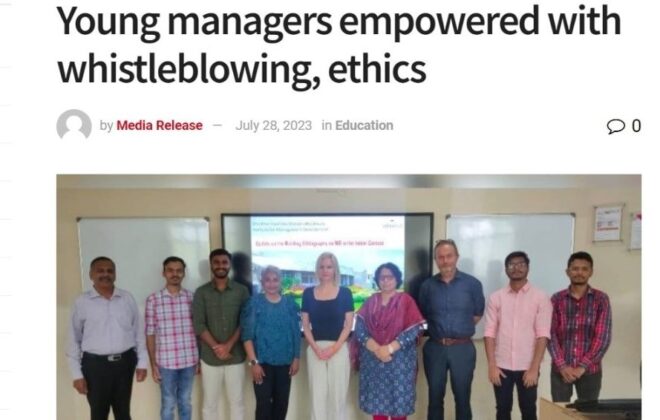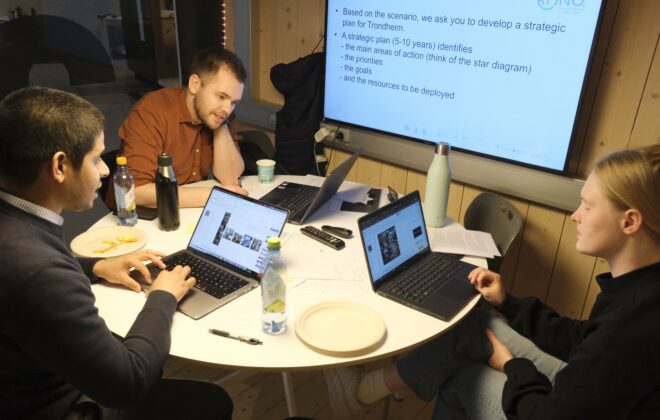Teaching RRI in higher education: For whom? Why? How?
“If one is truly to succeed in leading a person to a specific place, one must first and foremost take care to find him where he is and begin there. This is the secret in the entire art of helping.”
Søren Kierkegaard, The Point of View For my Work as an Author,
published posthumously in 1859.
Why should we teach RRI? For whom? And how? These are some of the questions addressed by the participants of the workshop ‘Teaching RRI through practice’, held online the 19th and 20th November 2020 by Anne Bremer from the Centre for the Study of the Sciences and the Humanities (SVT) at the University of Bergen. This workshop was the first of the AFINO Research School series and gathered together 16 participants, mainly from Norwegian universities and institutions. Among the participants there were PhD candidates, junior and senior researchers from a broad range of backgrounds (including design innovation, biosafety, corporate social responsibility (CSR), applied ethics, research integrity, philosophy of science and science and technology studies). Their varied levels of experience with teaching RRI made the discussions lively, with participants sharing their different expectations, but also the challenges they had met or were anticipating, relative to teaching RRI. To reflect on why, how and for whom to teach RRI, the participants were put in groups and tasked with drafting a PhD course module related to RRI. The objective was to learn about RRI in higher education through the practice of designing course modules – a form of learning by doing. This blogpost sums up some of the key reflections from the workshop, as well as how participants concretely suggested to overcome some of the challenges and tensions related to teaching RRI.
‘…find them where they are and begin there’ – The who and why questions
The workshop started with a presentation by Roger Strand from the SVT. His key message, illustrated by Søren Kierkegaard’s quote (above), was that before thinking about why and how to teach RRI, attention should be paid to who the audience is. Who is taking the course – what type of disciplinary backgrounds, positions, institutions are represented? What are they working on and how? What do they need? How can the course help them be ‘better’ at what they do? RRI courses should start from these questions, as they orientate why to teach RRI. Indeed, this was a theme that course discussions continued to circle around to.
There are many purposes to running an RRI course, and they should ideally be adjusted to the audience’s needs, and also to the length of the course. These purposes might include: (i) providing knowledge about how research institutions work; (ii) presenting the RRI concept in order to write a research proposal; (iii) introducing the different definitions, frameworks, dimensions of RRI, and how these came about; (iv) raising awareness about the contextuality of one’s own research, or (v) nurturing reflexivity, ‘practical wisdom’ (Mejlgaard et al., 2019) and ‘double-loop learning’ (Hesjedal et al., 2020) on the long term.
Adjusting RRI courses to the audience’s needs means allowing for some flexibility and openness in the planning of the course, so that modifications can be made as participants share their experience and express their most pressing issues, dilemmas, doubts or questions.
Slow and dialogic, safe and reflexive interdisciplinary spaces – The how question
The participants were then presented with three examples of teaching RRI in various settings (teaching RRI courses at the Centre for Digital Life Norway by Gisle Solbu, teaching ELSA courses at the Faculty of Medicine at the UiB by Anne Bremer, organizing RRI activities as part of the European HEIRRI project by Roger Strand). Following that, the participants designed their own PhD course module on RRI. Here are the key features that they found important for such course modules.
Slow and dialogic
According to the participants, an RRI course module should adopt a slow pace, as it allows both for individual and group reflections to mature and is conducive to having a dialogic setting. Not all RRI course participants have the opportunity to engage beforehand with RRI-type reflections, or with questioning the premises of their research or their discipline.
Having a slow pace is a way of stating: ‘this course is a space where you have time to think about your research/discipline in different ways, and you are allowed to voice your reflections, doubts, experiences and frustrations’. This slow pace also gives time to the teaching team to position themselves and make themselves available so that participants feel comfortable to reach out, might they face important doubts or resistance when ‘going back’ to their home institution, for instance.
In addition, moving slowly encourages participation, by taking the time to discuss individual reflections as they arise, and letting group discussions take place. This participatory setting ideally finds shape in formal, as well as informal settings, during the course and between lectures, in one-on-one supervision time, during fieldworks, walk-shops or in other activities connected to the course.
Establishing a long-term dialogue between participants, and with the teaching team, is important for nurturing an individual reflexive process without being overwhelmed by doubts, and for creating a sense of community among the participants.
Safe and reflexive interdisciplinarity
Creating an interdisciplinary community, where participants feel like they can share critical reflections in a safe space, was seen as another crucial aspect of RRI courses.
Interdisciplinarity is an important way for course participants to take distance on their own research by sharing, across disciplines, their various practices, experiences, in-built choices, values, tools and approaches.
An interdisciplinary setting indeed encourages reflexivity as it enables seeing one’s own research in a different light, by learning about what is done in other fields and how. An interdisciplinary setting also opens up new possibilities for creating bridges between disciplines that might address RRI issues in a more holistic and relevant way.
To facilitate this, the workshop participants saw an interdisciplinary teaching team as essential to designing and running RRI courses, but also saw course participants as resources in the course – by for instance letting them present their work, discuss their disciplinary approaches and assumptions in groups, and by discussing concrete RRI issues together.
If interdisciplinarity encourages critical thinking, it should be done in a safe way. Indeed, it is not unusual for RRI course participants to feel alone with the doubts, dilemmas and uncertainties they face in their everyday work. RRI courses can therefore act as a space where it is safe to critically reflect on the premises of one’s own research by being helped and supported by the teaching team. The objective is not to drown participants in further doubts, nor for them to fundamentally redesign their research (often, hierarchical constraints and precariousness of PhD positions make this impossible). Rather, it is about helping them uncover some blind spots, guiding them in reflecting about the assumptions and choices of their own research, and making them feel safer about their own project and choices made.
This is of course a long path, but interdisciplinary RRI courses were argued by the workshop participants to contribute to long-term resilience, by extending the course participants’ networks and by creating a safe community that can meet potential resistance within home institutions. Related to resilience building, it was seen as important for RRI courses to engage participants’ home institutions insofar as this is possible, either by inviting them to presentations and discussions at the end of the course, or by them joining fieldwork or other course activities.
A participatory design of RRI courses
This is what the AFINO research school is aiming for: to provide a slow, dialectic, safe and reflexive interdisciplinary space for thinking about the broader context of new research and technologies, and to create a community of junior and senior researchers who can share their experiences and challenges relative to RRI and CSR.
And as one participant put it: “A research school can be a good setting for encouraging RRI-type of critical thinking, as it leaves space for introspection and general reflection between the courses. And it’s good to know that we have a friendly RRI community out there to rely on. We are not alone thinking about these issues.”
The AFINO research school will take these reflections to design the PhD summer school of 2021. In that way, the participants of the workshop will have helped design their own summer school; one step in a long-term reflexive process.

Anne Blanchard
Anne Blanchard is a researcher at the Centre for the Study of the Sciences and the Humanities at the University of Bergen, where she is working on projects studying how science is employed for complex and uncertain climate and health challenges.
She is also the leader of The AFINO Research School. Read more about Anne at AFINO's webpage.




